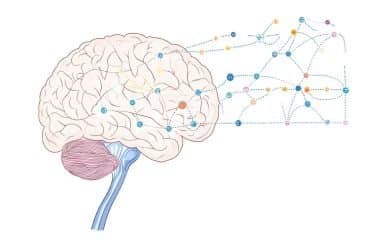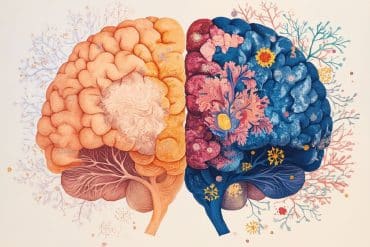Summary: Smartphone-based virtual reality games helped to reduce pain in young children with burns while having their dressing changed, a new study reports.
Source: Nationwide Children’s Hospital
According to the American Burn Association, burn injuries affect approximately 250,000 children in the United States each year. The pain associated with burn injuries extends beyond the injury itself; there is also significant pain from dressing changes, which can be exacerbated by the anxiety of anticipating this additional pain.
Although opioids relieve burn injury-related pain, they have serious adverse side effects. Prior studies have investigated alternative approaches to pain reduction in burn injury patients that focus on distraction, such as music, hypnosis, toys, and virtual reality (VR).
In a study published today in JAMA Network Open, Henry Xiang, MD, MPH, PhD, MBA, and his research team reported the use of smartphone-based VR games during dressing changes in pediatric patients with burn injuries.
“The smartphone-based VR game was very effective in reducing patient-reported pain,” says Dr. Xiang, a professor of pediatrics and epidemiology at Nationwide Children’s Hospital and director of the Center for Pediatric Trauma Research.
In the pilot study, designed as a randomized clinical trial, the research team divided 90 children, aged 6 to 17 years, into three treatment groups: active VR, passive VR, and standard care (e.g., toys, tablet). These patients, most with second-degree burns, received outpatient care for burn injuries between December 2016 and January 2019.
The VR game, called “Virtual River Cruise,” was designed specifically for the study by Nationwide Children’s Research Information Solutions and Innovation department. “Two factors were considered for the game’s design,” explains Dr. Xiang.
“The first factor was a snow, cooling environment within the game. The second factor was cognitive processing to encourage active engagement.”
Patients played the game using a smartphone and a headset. During dressing changes, which lasted approximately 5 to 6 minutes, patients in the active VR group actively engaged with the game; to stay still while playing the game, the patients tilted their head to aim a target, notes Dr. Xiang. Patients in the passive VR group only watched the game.
Along with their caregivers, patients reported their perceived pain and subjective experience with the game in post-intervention surveys. Nurses evaluated the game’s clinical utility.
Among the three treatment groups, patients in the active VR group had the lowest overall pain scores. Most patients and their caregivers reported a positive experience with the game, calling it “fun, engaging, and realistic.”
Nurses considered the game to be clinically useful in the outpatient setting. Previously, computer-based games were used during dressing changes. However, the computers’ bulkiness was not clinically practical. “Smartphones are easy to use, and most families have them,” said Dr. Xiang.

Given the VR games’ ease of use and demonstrated effectiveness at reducing pain during burn dressing changes, Dr. Xiang believes the game can also be played at home to relieve this pain.
“Pediatric burn patients still need dressing changes at home after hospital discharge, and these changes could be very painful,” said Dr. Xiang. Currently, Dr. Xiang is leading a research project, funded by the Division of Emergency Medical Service of Ohio Department of Public Safety, to evaluate the feasibility and efficacy of VR games in reducing pain during burn dressing changes at home.
The current opioid crisis underscores the need to continue to explore non-opioid approaches to controlling pain in burn patients. “The future research direction is to evaluate whether smartphone-based VR games have an opioid-sparing effect,” says Dr. Xiang.
About this neurotech and pain research news
Source: Nationwide Children’s Hospital
Contact: Press Office – Nationwide Children’s Hospital
Image: The image is in the public domain
Original Research: Open access.
“Efficacy of smartphone active and passive virtual reality distraction vs standard care on burn pain among pediatric patients” by Xiang H, Shen J, Wheeler KK, et al. JAMA Network Open
Abstract
Efficacy of smartphone active and passive virtual reality distraction vs standard care on burn pain among pediatric patients
Importance
It is unknown whether smartphone-based virtual reality (VR) games are effective in reducing pain among pediatric patients in real-world burn clinics.
Objective
To evaluate the efficacy of a smartphone VR game on dressing pain among pediatric patients with burns.
Design, Setting, and Participants
This randomized clinical trial included children aged 6 to 17 years who seen in the outpatient clinic of a large American Burn Association–verified pediatric burn center and level I pediatric trauma center between December 30, 2016, and January 23, 2019. Speaking English as their primary language was an inclusion criterion. Intention-to-treat data analyses were conducted from December 2019 to March 2020.
Interventions
Active VR participants played a VR game; passive VR participants were immersed in the same VR environment without interactions. Both groups were compared with a standard care group. One researcher administered VR and observed pain while another researcher administered a posttrial survey that measured the child’s perceived pain and VR experience. Nurses were asked to report the clinical utility.
Main Outcomes and Measures
Patients self-reported pain using a visual analog scale (VAS; range, 0-100). A researcher observed patient pain based on the Face, Legs, Activity, Cry, and Consolability–Revised (FLACC-R) scale. Nurses were asked to report VR helpfulness (range, 0-100; higher scores indicate more helpful) and ease of use (range, 0-100; higher scores indicate easier to use).
Results
A total of 90 children (45 [50%] girls, mean age, 11.3 years [95% CI, 10.6-12.0 years]; 51 [57%] White children) participated. Most children had second-degree burns (81 [90%]). Participants in the active VR group had significantly lower reported overall pain (VAS score, 24.9 [95% CI, 12.2-37.6]) compared with participants in the standard care control group (VAS score, 47.1 [95% CI, 32.1-62.2]; P = .02). The active VR group also had a lower worst pain score (VAS score, 27.4 [95% CI, 14.7-40.1]) than both the passive VR group (VAS score, 47.9 [95% CI, 31.8-63.9]; P = .04) and the standard care group (VAS score, 48.8 [95% CI, 31.1-64.4]; P = .03). Simulator sickness scores (range, 0-60; lower scores indicate less sickness) were similar for active VR (19.3 [95% CI, 17.5-21.1]) and passive VR groups (19.5 [95% CI, 17.6-21.5]). Nurses also reported that the VR games could be easily implemented in clinics (helpfulness, active VR: 84.2; 95% CI, 74.5-93.8; passive VR: 76.9; 95% CI, 65.2-88.7; ease of use, active VR: 94.8, 95% CI, 91.8-97.8; passive VR: 96.0, 95% CI, 92.9-99.1).
Conclusions and Relevance
In this study, a smartphone VR game was effective in reducing patient self-reported pain during burn dressing changes, suggesting that VR may be an effective method for managing pediatric burn pain.
Trial Registration
ClinicalTrials.gov Identifier: NCT04544631






